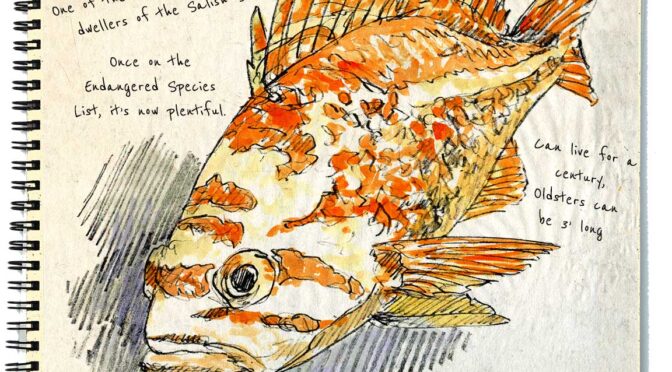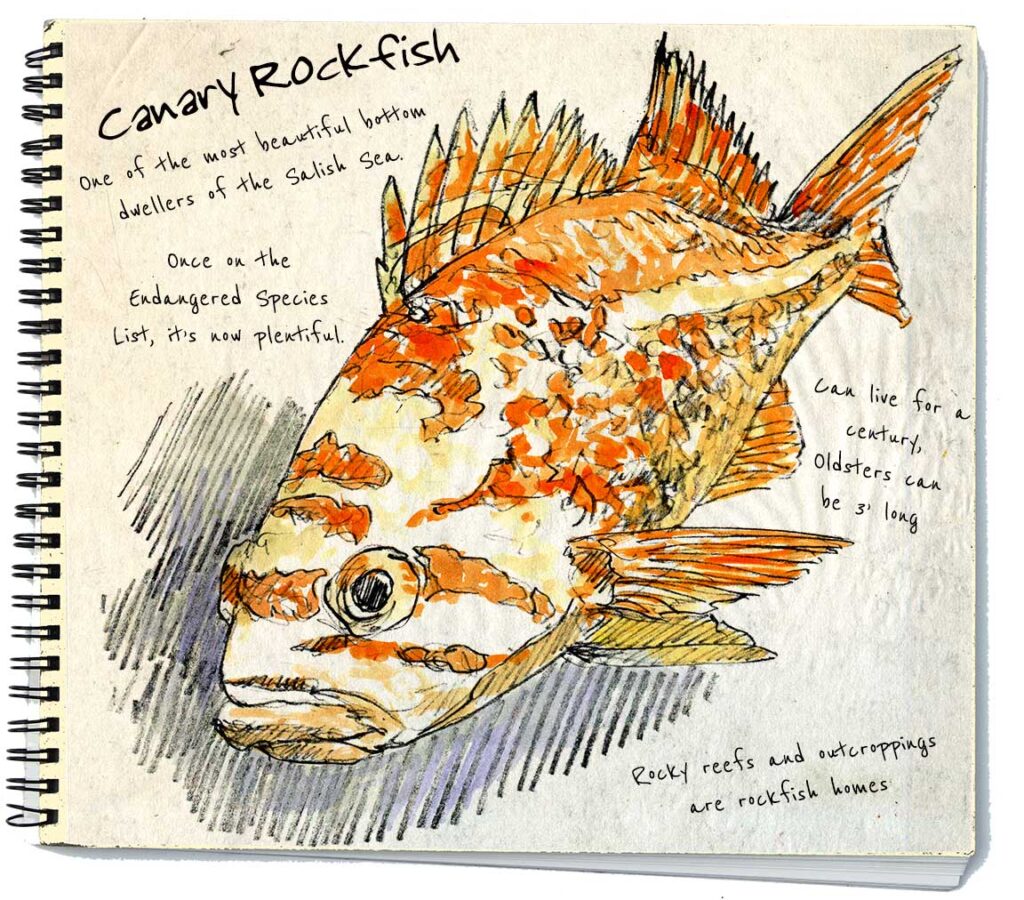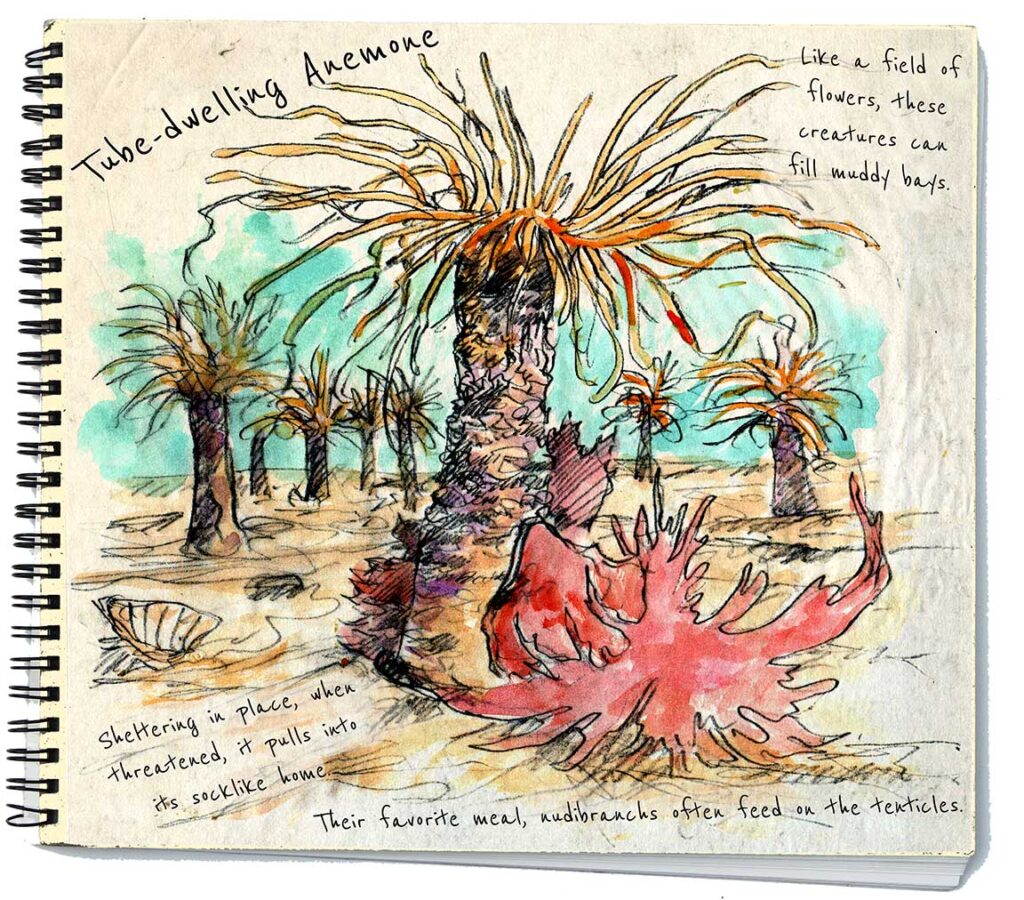Two new published stories, both in 48 North magazine a couple of months ago, the summer of 2020. This first story was about possibly the showiest and most colorful rockfish in the Pacific Northwest. It is sort of rockfish heaven here, with 17 different species, all somewhat different.
Here’s my sketch before the color version.
My story was about rockfish that can live to be over one hundred and how conservation can actually work using science. Imagine that, using science! BELIEVE IN SCIENCE! By the way, DID YOU VOTE?
Just as their name suggests, these guys prefer to live around rocks. 28 species of rockfish live in the Salish Sea, from 3-inch tide pool dwellers to 3-foot lunkers that live in deeper water and weigh in at 25 pounds. Most are slow-growing and long-lived, some live to be more than a century old. They have a completely different lifestyle from live-fast and die-young salmon. Foraging for other fish, they may swim only a few hundred miles in their lifetime. Rockfish tend to hang out together in groups around rock pinnacles or cliffs, places with lots of tidal current (which helps bring meals to them and not the other way around). Canary rockfish usually have three stripes angling down and backwards on the head, the middle one often runs across the eye. This is a very bright and distinctive fish.
The conservation of this fish is a real success story, and one that shows how science and government work together to make our lives, and the fish’s lives better. After discovering how good rockfish tastes, a definite over-exploitation of these tasty fish began in the 1800’s until canary rockfish were declared overfished in 2000 when it was discovered that rockfish had declined 70% since the 1960’s. Fish and Wildlife submitted a petition to have 14 rockfish species listed under the Endangered Species Act (eventually, all these were not listed). Enter science-based studies of them, plus just plain asking fishermen “where are you catching canary rockfish so we can have you fish elsewhere”. Fishing rules were changed, different gear was introduced and suddenly, in half the time it was thought it hopefully might happen, we have plenty of rockfish.
My second story was about another Northwest creature, one that has adapted to its environment in a beautiful way, but hiding underground from its predators.
A delicate flower-like anemone that is actually an animal. Yes, an animal that you’ll find just beneath your keel in sheltered mud-bottomed bays. While it looks more like a tube worm, this creature is actually related to jellyfish. Confusing, but to me it just shows the complexity of the underwater world we rarely see, and why I enjoy writing this page. These animals appear to have stout tubes below their tentacles waving in currents as they search for bits of food to snag, but they are actually soft and vulnerable. To protect themselves, they burrow into the mud and generate a fibrous string-like material they weave around themselves, almost like they’re knitting a sock. This can extend from above the surface down beside them into the mud as deep as three feet, a woven structure they live in, safe from predators. When one threatens, the anemone quickly pulls itself down into the protective tube.
While many anemones have stout fans of tentacles and large bodies holding them up into the current, this species relies on the mud substrate and a house of its own making. When its main predator, the giant nudibranch, grazes on the anemone’s tentacles, it also lays its eggs right on the outside of the anemone’s tube, putting the young’s first meal close at hand. You might think this would be the end of the anemone, but nature has evolved tentacles aplenty so both species survive. The anemone commonly lives up to 10 years and often congregates in colonies that resemble flower-filled meadows, the tenticles waving as blossoms in a gentle breeze. Flowers they are definitely not, animals are certainly are.
And here’s my original sketch before the color was added. Notice the unfinished part on the right, just part of the process.

I’ve written for this magazine for over a decade now. When it was a sailing journal, they used my art on the covers and published many of my longer stories. It’s a broader publication now, trying to a bigger audience, and it still gives me pleasure to contribute. It was sold to the Port Townsend Northwest Maritime Center a couple of years ago, bringing it closer to my home port where I continue to sail and kayak. It’s a meaningful bit of life to me, experiencing nature here at home and then writing and painting it for others to enjoy.
Thanks for reading this week. You can sign up for emails for these posts on my website at larryeifert.com.
Larry Eifert
Here’s my Facebook fan page. I post lots of other stuff there.
Click here to go to our main website – with jigsaw puzzles, prints, interpretive portfolios and lots of other stuff.
Nancy’s web portfolio of stunning photography and paintings.
And here to go to Virginia Eifert’s website.



